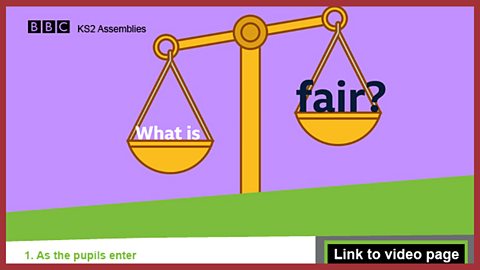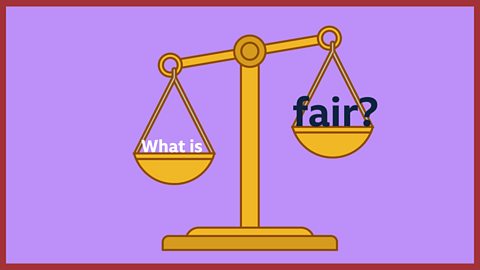In short...
Themes: Fairness; equality; justice; what is 'fair'?
Summary: How often do you hear someone say 'But it's not fair!' This assembly gives pupils an opportunity to consider what 'fairness' is and to consider how they can try to make sure they treat everyone else 'fairly'.
Resources: the . Also some props - a large ball and a small one - for the introductory activity and a set of balancing scales. You could if you cannot source the scales. There is also a following the introductory activity.

The video
The video starts with a primary school pupil giving a brief explanation of what fairness means to them and some examples of unfairness.
He asks: 'How can you make sure that you are always treating people fairly? What could you do if you see someone being unfair? Why is it important to be fair?' He is then joined by some other pupils to consider these questions.
Duration: 3' 53"
Last words: '…caring for animals the way they should be cared for.'
Video questions
- Are there things in your life that aren't fair?
- Have you ever been treated unfairly by someone else?
- Why do you think it is important to be treated fairly?
- Is getting paid less for the same job fair?

Key links
Download / print the assembly framework ready for use

Click to display the image full-size


Suggested framework
1. Entry music
Play your chosen music as pupils enter.
2. Introduction
Invite two pupils up to the front to take part in a competition. You could pick one of the oldest pupils and one of the youngest. Say that you want to see who is best at catching, and you will give a sticker to the best catcher. Stand the older pupil really close to you, and throw the biggest ball for them to catch, making sure they can definitely catch it. Then say it is the next pupil’s turn, but this time stand them a long way away and throw a much smaller ball. Do your best to make sure they don’t catch it. Award to ‘The Best Catcher in School’. Wait for protestations from the rest of the pupils and ask a few to explain why what you have done isn’t fair. How could you have made it fairer?
Have a set of balance scales heavily weighted to one side. Ask, how can we make them equal? Move the weights until both sides are balanced, and explain that balance scales have often been used as a symbol for fairness because both sides must contain exactly the same. To treat people fairly, you have to give them the same chances.
Introduce the video by saying we'll now watch a short film in which some schoolchildren consider what they think it is to be fair.
3. The video
Play the video. The duration is 3' 53" and the final words are: '…caring for animals the way they should be cared for.'
4. After the video
Ask the pupils to spend a few moments reflecting on what they saw in the film and thinking about the question 'Why is it important to be fair?'
5. Time to talk
Take a few answers from pupils about why it is important to be fair and then ask: 'How can you make sure that you are always treating people fairly? What could you do if you see someone being treated unfairly?'
6. Opportunity to sing
An opportunity to sing your chosen song. Suggestions from ≥…»ÀøÏ ÷ collections below.
7. Opportunity to reflect
Invite the pupils to close their eyes and picture the balance scales from the beginning of the assembly.
We all have a sense of what is fair and what is unfair…
We all know what it's like for things to feel unfair…
Think about how you will try to act fairly in everything you do today…
8. Opportunity for prayer
Use your normal form of address ('Dear God' etc) and:
Help us all to think of others…
To treat them fairly…
And to help when we see them treated unfairly.
Amen.

Suggested songs
Song: 'Keep the golden rules' (All about our school, no 5. Vocal version)
Chorus:
Every day’s a good day
When we keep the golden rules.
Then we’ll get on in a good way
With everyone at school!
Show respect for one another
And different points of view,
And take good care of each other
In everything we do.
Verse 1:
They’re all there for a reason,
So everything is cool,
And every day’s a good day
When we keep the golden rules!
Chorus:
Verse 2:
There are rules for playing every sport
And every kind of game,
To get along together
We need rules just the same!
Chorus:
Every day’s a good day
When we keep the golden rules.
Then we’ll get on in a good way
With everyone at school!
Show respect for one another
And different points of view,
And take good care of each other
In everything we do.
And take good care of each other
In everything we do.
Song: 'While we live we learn' (All about our school, no 3. Vocal version)
While we live we learn, (while we live we learn,)
While we learn we grow, (while we learn we grow,)
And the more we grow, (and the more we grow,)
So the more we know, (so the more we know,)
And the more we know, (and the more we know,)
Then the readier we will be
For all life's big adventures
And all life's mysteries.
While we live we learn, (while we live we learn,)
While we learn we grow, (while we learn we grow,)
And the more we grow, (and the more we grow,)
So the more we know, (so the more we know,)
And the more we know, (and the more we know,)
Then the readier we will be
For all life's big adventures
And all life's mysteries.
For all life's big adventures
And all life's mysteries.

